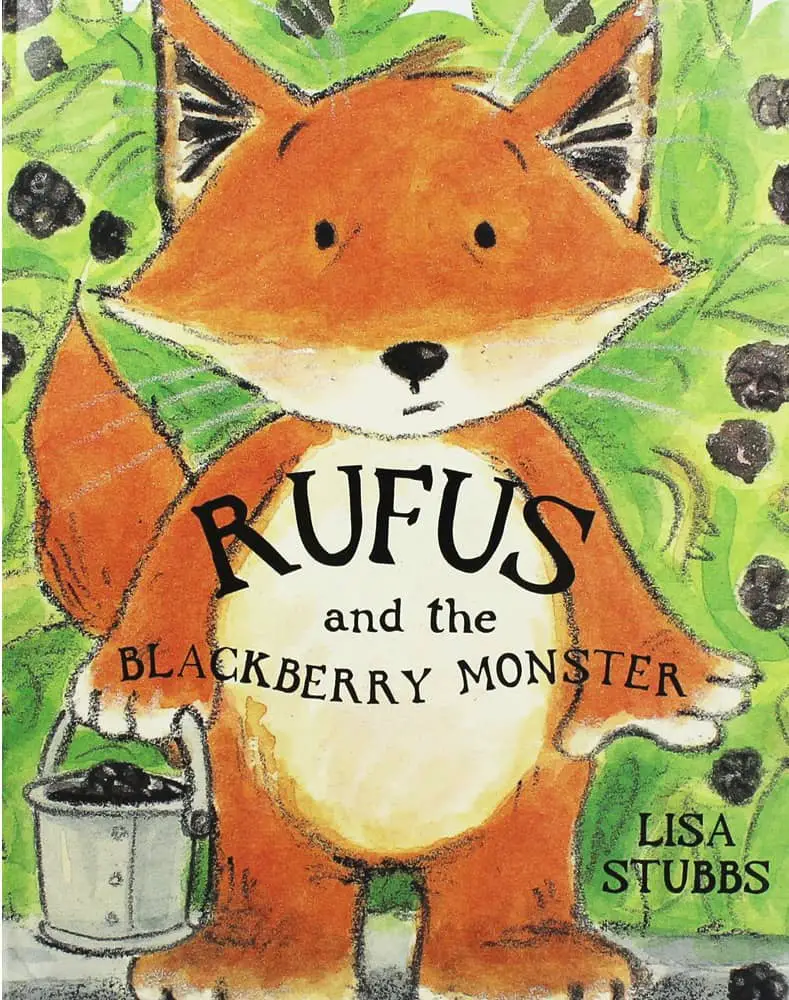1999 in picture books was the year of monsters in the forest. Jez Alborough was finishing up his bear series about a massive toy bear, actually harmless. Julia Donaldson and Axel Scheffler released their phenomenal hit The Gruffalo. Rufus and the Blackberry Monster by Lisa Stubbs is part of the same family. Comparisons between this story and The Gruffalo are inevitable — both picture books feature young animal characters who are warned of a big, bad monster in the woods. Is the monster real or isn’t it? This is saved as the big reveal. The young characters must muster up courage.
Apart from the setting and the set up, these two stories are quite different.
Rufus doesn’t like picking blackberries because the blackberry bush at the bottom of the garden is big, dark and scary! Archie, his big brother, makes matters worse by telling him about the Blackberry Monster. When Rufus hears rustling noises while picking blackberries, he wonders whether there really could be a Blackberry Monster.
Marketing copy of Rufus and the Blackberry Monster
The characters in this story happen to be foxes, but there is nothing fox-like about them apart from their physicality, similar to Pearl the pig in The Amazing Bone by William Steig.
STORY STRUCTURE OF “RUFUS AND THE BLACKBERRY MONSTER”
Page one opens with a Call to Adventure as a mother fox sends her two sons out to the forest (actually to the garden) to collect blackberries. The mother plans to bake a pie for Amber’s birthday tea. This is the sort of gender dynamic we’re seeing published less often these days — a mother who stays in the house with the only girl while boys go out on their mythic adventure. (Ostensibly the daughter stays at home because she is too young, but remember these characters were created and gendered from literally nothing, same as any fictional cast.) Gender inversions are becoming more common (though inversion doesn’t equal subversion).
SHORTCOMING
In stories, especially ones drawing upon fairytale symbolism, the younger brother is at a disadvantage over an older one: weaker, smaller, less worldly and therefore more gullible. Rufus is the younger of the two brothers and from page two the story is focalised via the point of view of Rufus:
Rufus loved blackberry pie, but he didn’t like the blackberry bush at the bottom of the garden. It was BIG and DARK and SCARY!
DESIRE
The reader easily intuits what Rufus wants: He wants to stay home safely, but he goes along with his brother because he doesn’t want to be seen as cowardly, or face other consequences of refusing his mother’s wish for blackberries. Like the reader, he wants a piece of this delicious pie!
OPPONENT
Archie is Rufus’s older brother opponent. Archie is having a lot of fun teasing his younger brother about a so-called Blackberry Monster. The authorial voice tells us exactly how to think of Archie, with phrases like ‘in a bossy voice’, ‘sniggered’ and by description of his selfish actions: ‘He had taken the sunny side for himself.’ Hoardy characters are never good in picture books, aimed at an age where the audience is learning to take turns and share.
The Schrodinger’s Cat Minotaur Opponent is the Blackberry Monster.
Importantly, the reader doesn’t know whether the Blackberry Monster is real or not in the veridical world of the story. This places us alongside Rufus in terms of story world knowledge and we identify with Rufus, not with Archie. There is nothing subtle about how this is established, catering for a very young audience who see goodies (Rufus) and baddies (Archie) in black and white.
Later, Lisa Stubbs gives form to the purple monster by drawing an imagination bubble coming out of Rufus’s head. The monster isn’t all that scary as far as monsters go, again catering to a young audience who are likely reading this before bed.
PLAN
Rufus asks Archie about the Blackberry Monster as they walk down the garden path. The more he learns about the monster, the better prepared he’ll be. Archie’s descriptions of this monster are conveyed to the reader as well as to Rufus; tension builds.
Also importantly, the author tells us exactly what’s at stake should this monster prove to be real: “If he catches us he’ll eat us up in ONE GULP!” The word ‘ogre’ isn’t used in the book, but this is the monster archetype she is describing. (The main difference between ogres and giants: Ogres have huge appetites. Giants are just big.)
“I MUST be brave,” thought Rufus.
Feeling the fear and doing it anyway is a message straight out of the 1990s. The self-help book by Susan Jeffers was published in 1987 and became more and more popular over the coming decade.

In contrast to this strain of self-help, Gavin de Becker published The Gift of Fear in the year 2000, marking the American (Western) self-help shift from ‘be scared and plough onin’ to ‘trust your instincts and STOP’.
A date won’t take “no” for an answer. The new nanny gives a mother an uneasy feeling. A stranger in a deserted parking lot offers unsolicited help. The threat of violence surrounds us every day. But we can protect ourselves, by learning to trust—and act on—our gut instincts.
Marketing copy from The Gift of Fear
Both of these messages have their place. Guess which is the more common in picture books, where readers are assumed to be inappropriately anxious, on the assumption that caring adults won’t push them beyond what they can cope with?
BIG STRUGGLE
Like many picture books, the battle phase of Rufus and the Blackberry Monster comprises a large proportion of the total story. The lead in to this phase utilises the horror story jump scare:
Rustle, crackle, rustle, snap! went a noise.
Rufus turned around. There was nothing there.
After a page turn Rufus wants to run home ‘and forget about being brave’, because according to 1990s ideology being brave doesn’t include embracing a flight response; only a fight response.
The ‘monster’ is revealed slowly, first via a larger-than-life shadow, which is an advantage in the work of an author/illustrator — seamless integration between text and pictures.
The page which depicts Rufus running away from the ‘monster’ is interesting because now we have a character running away from the natural page turn of the book. When illustrators do this there’s always a good reason. Rufus does not want to see what’s over the page.
Of course, we do!
ANAGNORISIS
The plot reveal: A monster exists, but it is simply a mouse. The mouse’s shadow and rustlings have been magnified by imagination.
The character reveal: Rufus has learned two things. He is in fact braver than his brother (by the standards described above). The reader knows this too because the big brother hides behind Rufus. Rufus also learns that if he faces his fears, the fear will shrink in size, actually, as well as metaphorically.
It makes sense that Archie is more scared than Rufus of the monster because the purple ogre is a product of Archie’s imagination. In the telling of it, he has successfully scared himself. This is the perfect example of a gentle revenge story, letting natural consequences kick in.
NEW SITUATION
Rufus is underscored as the sympathetic character when he invites the hungry little mouse home for blackberry pie. Save the Cat moments generally happen early on in a narrative as the characterisation is being established, but this picture book is an example of Save The Cat used at the end of a story, to remind us how good, kind and generous our main character is.
There is a warm, cosy kitchen scene as all the characters make a mess of themselves eating blackberries. The mother is utilised as a reassuring presence by telling them they are all Blackberry Monsters. This is your classic home-away-home story structure. It’s a tried and tested structure and works very well.

